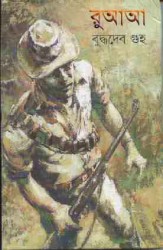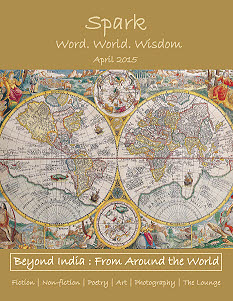by Shom Biswas
Last month, while on a flight from Boston to London, I got talking with the next-seat neighbor. She was a Bostonian brunette of my age or nearabouts, and we connected easily on the commonality of our mid-thirties, middle-income, middle-management existence, of the safety and the perils of a regular vanilla job, of the realization that we are not the designated ones to change the world, and the common plan of retirement from the rat-race at fifty.
My co-traveler was not on an office trip though, she will be on vacation in South Africa. To Cape Town. To the Krueger National Park, amongst others. I love reading about wildlife and have pretensions of being a world-traveler, so this was exciting conversation for me. She turned out rather well-informed, and was sharing nuggets about travel in Africa. And while talking about Wildlife Parks in Africa, she uttered that magic word. Five letters. R-U-A-H-A. And for a moment, I was back in my tiny town, holed up in my attic, poring through another of Rijuda’s shikaar stories.
For a very long time when I was young, I spoke and read almost exclusively in Bengali, my mother tongue. The Queen’s language was reserved only for conversation with my school teachers or for reading school text books. While this could be a hindrance for many to-be readers in other Indian languages, Bengali thankfully boasts of a rather large oeuvre of children’s and teen literature. And translations of “Children’s Classics” in Bengali.
Almost all of the most reputed novelists and litterateurs of the Bengali language had tried their hand at literature for the young, with varying degrees of success. Satyajit Ray, one of the greatest minds of modern India, spent all his writerly-life writing for children and teens in Bengali. Two of my favorite Bengali writers, Ashapoorna Devi and Sunil Gangopadhyay were, however, in my opinion, merely moderate writers for the young. Another literary giant, Shirshendu Mukhopadhyay, though, was very competent at literature for the young. But one of the best was Buddhadev Guha. Guha was a good, solid and famous writer for the older reader (‘Koel’er Kachey’ and ‘Madhukari’ are fine novellas), but where he shone was when writing for the young. No one but for Satyajit Ray’s Feluda of that time would compare with Guha’s Rijuda, for me.
A lot of Guha’s writing, including those for an adult readership, was with the backdrop of the Indian forests and wildlife. His stories, though, are in most cases very urban and very urbane. Guha did not write of the forests by making the people of the forests the main protagonists, the way a Mahasweta Devi or an Adwaita Malla-Barman would. His stories were often with urbane protagonists in a forest backdrop, their interaction with other urbane characters, and once in a while their interactions with some people of the forests too. You could debate that this did not allow the reader to see the perspective of the actual people of the forest, thus our experience would be incomplete. But I think Guha, a part of the urbane, cultured and moneyed elite of the Bengali society, wrote about what he knew. And since he wrote from the point of view of people-like-us (or people-we-aspire-to-be if you will), the stories were always relatable.
Before going into Rijuda, let me quickly touch upon Dada-literature, which covers a substantial part of the oeuvre of Bengali literature for the young. In such stories, the protagonist / narrator of the stories would be a character of indeterminate young age (ranging from high-school in the case of Topshe of Feluda’s stories to early 20s in the case of Sudheer of Ghanada’s stories), who would narrate an incident or an adventure featuring himself and the dada (translated as ‘older brother’ but generally used for any man who is older, but not so much that there’s a generational gap between the two. The appendage – da to any name, as in Feluda, Ghanada, Rijuda etc., is the same as dada). And since the protagonist is of the age of the people who the book is intended for, the association is natural and these mostly being adventure stories, the young reader gets tagged along with the characters and events of the stories.
Rijuda’s stories, narrated by his cousin and companion Rudro, are primarily tomes of love for the Indian flora and fauna, but Rijuda’s reputation is built on being a hunter of man-eating tigers and leopards. Following the well-trodden footsteps of Jim Corbett and Kenneth Anderson, the stories of Rijuda, albeit fictional, have their place in the pantheon of Indian shikaar-writing (i.e. stories about hunting). For me, though, the significance was two-fold. Being from a small town in a nondescript part of Bengal, the two worlds Rijuda and Rudro inhabit, the jungle-traveler and the urban sophisticate, were both some kind of aspirational ideals.
Ruaha was my favourite Rijuda-story. It was not the first Rijuda-story that I read, it was probably the fifth. My mother, who worked in LIC, was a member of the office library. And it was from the LIC office library that she had borrowed for me a copy.
Ruaha is one of only two stories where the writer takes Rijuda to the African forests. The previous, ‘Guguno-Gumbar-er deshey’ was when Rijuda and Rudro have taken on a group of poachers and animal traffickers, have been betrayed by their companion and failed, and Rijuda was shot and left to die, only to be rescued and brought to safety by Rudro. Ruaha is the continuation of that story, where to finish off the work left unfinished, Rijuda and Rudro travel to the Ruaha national park in Tanzania. They are joined in their quest by Titir Sen, a super-intelligent, super-pretty, champion-shot, super-everything-really girl, and few would debate that it is the addition of Titir, along with the addition of Africa, that makes the story the best of all Rijuda stories.
You know, for us small-town kids, in those no-internet days, with very little connection to the big bad world outside our little cocoon, Kolkata was this mysterious, magnificent place, inhabited by the Titir Sens of the world. Kolkata women, how amazing they must be! Aspirational? For a very long time, say up until about eighth standard or so, my only aspiration was to live in Kolkata when I grew up. That’s all.
Ruaha is not much of a shikaar-story, and more of an adventure, a romp across the flora and fauna of Africa. And I remember it as a glorious, thrilling read; with memorable characters in Wanaaberi, Sergeson Dobson, Vushunda and the Tornado gang.
On coming back home to India, I decided that I had to have a re-read of Ruaha. I had expected disappointment – these things generally don’t pan out the way we want them to. Some of my favourite books of my younger days have fallen out of favor on re-reads, so much so that I am fearful of revisiting anything that I had read as a teenager.
But Rijuda had to be given a re-visit. Ruaha beckoned, as did a favourite corner of my childhood.
I was, thank goodness, not disappointed. The thrill was still there. That chill in the stomach – what will happen next – was there, even though I remembered the ending. One can debate that some of the parts have not aged well, that the book was a product of its times; but if you allow it that flexibility, you would soon be drawn into the world of Rijuda and Rudro and Titir.
So I decided to read some more of Rijuda. I next read Rijuda Somogro – Part 5, a collection of Rijuda’s stories; and as you would understand from the ‘Part 5’ in the name, that this was a more recent collection (while Ruaha would have been written in the early 1980’s). These are five stories based in the forests and sanctuaries in India, in the Hazaribagh and Koderma areas of present-day Jharkhand; and in the Andhari-Tadoba sanctuary in Maharashtra and Madhya Pradesh and nearby. There’s a detective story too, but that does not quite work out. Rijuda was not meant to be a detective.
This is a stellar collection otherwise. There is indeed some shikaar, but mostly the stories are just about the forests – how the look, what they smell like, how they are. The writer mentions, in the introduction, that he is saddened that once in a while, he has had to include a shikaar to the story on the demands of the publisher, while what he had meant to write was just a story about the forests. And excellent they are, the stories of the forest.
I quite like how the writer has made that compromise of including within those stories a shikaar. I think decades of dealing with editors has made him learn this trick. Many of the stories are for all purposes stories of the group’s travel across a forest. But then, in the evenings, when the forest resort is enveloped with the ambient night-sound of the wild, when the group has gathered in the drawing room while the dinner is being cooked, Rijuda would light up his Meerschaum pipe, settle down in his armchair, and regale his group of friends and admirers with stories of some long-ago hunts that he or some friend of his was a part of.
They are beautiful. I wish I were part of such an evening gathering.







Wow! This so took me back to my childhood days. Buddhadeb Guha was such a favourite of mine when I was young, along with Sunil Gangopadhyay’s Kakababu. Yes in those days, we were imaginative lads growing up on Bengali literature with an idealistic view of the world. Till we knew better. Which kind of leaves our childhood like an island of memories difficult to cross to nowadays. Regards.
May be Mr Shom, you could translate Rijuda from Bengali to English for those young people who do not know the language…
Excellent piece, Shom. I grew up reading Corbett and can imagine the wonderful times you had with Guha. I’m glad you’re writing about these amazing writers who are unknown outside of Bengal.